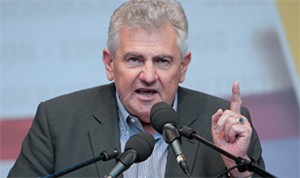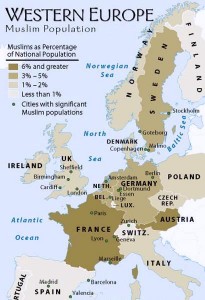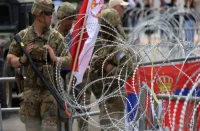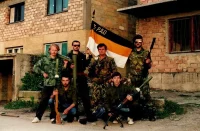Today the Old (dying out) Continent is under multi-faced crises pressure some of them having older roots but the others are product of current political decisions and moves by the European decision makers (and those who are behind them across the Ocean).
The European oldest and mostly painful crisis-problem is a biological declination of the whole continent what from the economic point of view means, at least for the western countries, an import of a huge number of the „outsiders“ in order just to keep the same level of the economic production and national GDP. This solution of course produce as a counter effect and the problem of multicultural coexistence or integration of the „guest-workers“ into the local (Christian) society. The fact is that the process of multicultural and multiconfessional integration of the „outsiders“ already failed while at the same time the „guest-workers“ are gradually winning the biological battle against the (West) Europeans – a syndrome we can call as a „Kosovization of Europe“.
Recently emerged an extra crisis-problem for the Europeans that is a radicalization of the Islamic local communities with a consequence of facing a real Jihad war on the streets of the West Europe. The reasons for such Islamic radicalization of the local West European Muslims, who are in several countries already approaching 10% out of total population, are of different nature – from the political ideology point of view to the pure policy of revenge to the Western atrocities in the Muslim world countries in the post-Cold War era and their military occupations by the NATO’s machinery in a classical manner of the West European imperialistic colonialism from the past. Currently the West Europe is in an open struggle with the Islamic Jihadists as a matter of their revenge to the West European primitive, barbaric and dirty caricaturing of Prophet Mohammed that created a new syndrome – a „Jihadization of Europe“.
Kosovization of Europe
What is „Kosovization of Europe“ and how it works? It was for the first time mentioned in 2008 in Strasbourg when the deputy of Austrian Freedom Party, Andreas Melzer, at the European (Union’s) Parliament (the EU Parliament) in the mid-November expressed common West European fear of the „Kosovization of Europe“ syndrome, taking into account the destiny of ethnic Serbs in Kosovo province and historical background of the phenomena how today Kosovo became predominantly Albanian. According to his opinion, not only Austria, but in general, the biggest part of Europe is going to experience „Kosovo syndrome“ in the next 50 years. More precisely, not only for Mr. Melzer, but for all European experts on demographic trends in contemporary Europe, it is obvious that autochtonous European population (i.e. nations) are seriously biologically decreasing in numbers while

immigrants are gradually becoming more and more numerous with a tendency to become majority in the mid-21st century. For instance, according to the British state statistical department’s report several years ago, in the year of 2066 in this country has to be more immigrants than the native (UK) inhabitants.
This tendency of „Kosovization of Europe“ was exactly the main part of Melzer’s „warning message“ when he was speaking at that time in the EU Parliament on the current immigration policy by the European Union, remained his colleagues that originally Kosovo was center of Serbian medieval state with clear majority of ethnic Serbs. Here, it has to be mentioned that according to official censuses (Ottoman, Serbian, Yugoslav, the UNMIK, or Austro-Hungarian estimations) in 1455 in Kosovo it was only 2% of the Albanians (located in Djakovica area on the very border with today Albania), in 1878 30% but in 1913 50%, in 1945 70%, in 1991 90% and today 97%.[1] A. Melzer was right when he was telling in the EU Parliament that the ethnic majority in Kosovo passed gradually to the ethnic Albanian side primarily due to the Albanian (biggest in Europe) natural birth rate, but historians are obliged to stress the fact that it was done and due to the policy of ethnic expulsion of the Serbs during the Second World War (when Kosovo was part of a „Greater Albania“), as well from 1974−1989 (when Kosovo Albanians enjoyed very high provincial autonomy, i.e., independence[2]) and finally after June 1999 up today (when all Serbian state authorities left Kosovo).[3] Anyway, today the Serbs are, how Melzer said, „disappearing minority“, on their own historical land due to the Albanian natural birth rate (and ethnic cleansing policy). At this point, the issue is that almost the same natural birth rate have and immigrant Albanians in Austria and in other European countries, even now encouraged by state financial subsidies and higher salaries under the West European economic conditions. Naturally, in two generations the absolute majority of „autochtonous Austrian inhabitants“ are going to be very questioned, particularly if we have in mind that, according to the Austrian state statistic department, today 16% of Austria’s population is of the „foreign“ origin (the so called „gastarbeiters“ – „guest- workers“) with the city of Vienna with 30% of non-German native speakers.
Very similar situation is in Germany and France as well. Even ethnic Germans from Germany are making jokes concerning the new name of their country in the future: the best name candidates are like „Northern Turkey“ or the „Second Ottoman Empire“. Surely, the biggest minority in Germany today are the Turks (or the „Germans of Turkish derivation“). The term “foreigners” is synonymously used for them. According to some sociological investigations, nearly half of the Germans agree with the statements: “foreigners take away our jobs”, “they don’t want to become integrated, especially the Turks don’t want to learn German” or “foreigners make loud music, they only have pretensions and don’t want to work”, etc. Nevertheless, the German government is aware of “de facto” situation in Germany and in order to encourage the Turkish incorporation into the German society and especially to improve the German-Turkish relations, for instance, opened in Berlin the Institute for the Turkish studies in the building of the pre-WWII Yugoslav embassy. However, in 2008 the German kanzellar Angela Merkel stated that unfortunately governmental policy on “gastarbeiters’” integration into the German society failed.
Predictably, one of the biggest problems with a higher natural birth rate of the immigrants (especially the Albanians) in the West Europe is going to be in the very recent future the armed conflicts between their different tribal and criminal groups on the streets of the West European towns of course combined by the Islamic fanaticism phenomena that is currently in a very speedy process of developing as a matter of the Islamic revenge to deliberate West European Christian provocations a la „Charlie Hebdo“ and other similar actors in the same style. For example, many Albanians (and from Kosovo and from Albania, Montenegro and Macedonia) are still living according to their feudal tribal laws which includes and „bloody revenge“ as well.[4] For instance, one NGO from Albania reported in 2004 that more then 3,000 Albanian boys are hidden in their homes in order to avoid death penalty by the members from opposite tribes or „extended kinship family“. It has to be known that „bloody revenge“ practice is a duty of all members of the tribe including and those abroad (the „guest-workers“) and this duty has to be accomplished even by the next generations. There were recorded already several „bloody-revenge“ post-Kosovo independence cases by the Albanian workers from Germany who were using summer vacations to visit their families in Kosovo but and to commit „bloody revenge“ duties (the number of not officially recorded cases by Kosovo  police is a matter of guessing). The same „bloody revenge“ customary law policy works and to the opposite geographic way: there are recorded cases of implementation of the „bloody revenge“ duty in the West European countries by the new emigrants or simply „tourists“, or even by those who are already for many years the guest-workers as the realization of the family or tribal „bloody revenge“ duty does not recognize international state borders.
police is a matter of guessing). The same „bloody revenge“ customary law policy works and to the opposite geographic way: there are recorded cases of implementation of the „bloody revenge“ duty in the West European countries by the new emigrants or simply „tourists“, or even by those who are already for many years the guest-workers as the realization of the family or tribal „bloody revenge“ duty does not recognize international state borders.
For the matter of illustration how the „blood revenge“ works among the Albanians, we will cite the article „The Curse of Blood and Vengeance“ from The New York Times Magazine (December 26th, 1999) by Scott Anderson:
“In remote northern Albania, communal life is governed by ancient codes of honor unchanged by modern notions of rights or the rule of law. That’s why Shtjefen Lamthi was gunned down in broad daylight – and why his killer’s family will probably get theirs too, someday.”
By conservative estimate, at least 200 people withnessed the murder of Shtjefen Lamhi in Shkoder, the northernmost city of Albania, early on the afternoon of Aug. 3, 1998. The 43-year-old farmer was walking south along Zyhdi Lahi Street, one of the main thoroughfares of the Rus marketplace in downtown Shkoder, his hands weighted down with plastic bags filled with his day‘s purchases. Just in front of a small tobacco kiosk at the northwest corner of Rus Square, a burly man who looked to be in his mid-30s suddenly stepped into Lamthi’s path, brought up a Kalashnikov assault rifle, shot him 21 times and walked away. None of the witnesses came forward to identify the killer. Instead, a wall of silence immediately descended. Today, 16 months later, Lamthi’s murder remains officially unsolved, despite the fact that almost everyone knows exactly who killed him. A strange event, but not in Albania [and among all Albanians wherever they live].[5]
Jihadization of Europe
The phenomena of „Kosovization of Europe“ is currently followed by another syndrome – „Jihadization of Europe“. Deliberate provocations by the western Christian media (like it was several years ago in Denmark or now in France and so on) of the Muslim world by very primitive and totally unsalted caricatures of Mohammed are surely with strong political support and background. The aim is to start a new crusade war against the European and other Muslims but in order to do that the action has to obtain a mass support by the European (West Christian) citizens. The easiest way to do that is to provoke Islamic radical groups to do several terror acts across the West Europe leaving dozens or more people shot dead on the European streets or squares. After several of such repeated West Christian provocations and bloody vengeance by the Muslim radicals the West European Christian masses can be coordinated to the „right“ direction of the „final solution“ of the Islamic Question in the West Europe (and elsewhere) under the motto of „Free Speech“ rights protection and of course protection of Europe from the Islamic radicalization and jihadists. However, that is not the end of the issue as the final aim of such anti-Muslim policy of provocations can be Russia, i.e. the Russian Muslim society. Russia of course as all other Orthodox Christian states, churches and societies has nothing to do with the West European „caricature barbarism“ but supposedly Russia’s Muslim radical groups can react on the same way as their West European colleagues are already doing by not making any difference between the Christian Catholic, Protestant or Orthodox believers. Such development of relations in Russia between her Muslim communities and the Christians will for sure very much destabilize the country which already is facing sanctions by the West because of the Ukrainian crisis. Exactly what a perfidiuos Uncle Sam wants.
Here we can not forget a crucial point of the Islamic political ideology concerning the „national identity“ question: all Muslims around the world are belonging to a single „Mohammed nation“.[6] As religion (Islam) is the only national identity factor for all Muslims the result is that any ethnolinguistic difference  on the national base is not allowed. It means, for instance, that the Muslim Albanians are firstly the Muslims and than the Albanians, etc. The crux of a matter is that the Muslims around the globe are seeing the West European „caricature barbarism“ provocations as something that really deserves an Islamic „bloody revenge“ and that is a duty by all Muslims regardless on their ethnicities. Therefore, mini, regional or private and party’s Al-Qaedas are already growing rapidly. Protests against „caricature barbarism“ are spread out all over the world from the Sanjak region in Serbia and quasi state of Kosovo via Kurdistan to Pakistan involving different etnicities of the Muslim believers. For instance, the Sanjak region Muslims (the Bosniaks as they identify themselves) in Serbia are not the Turks or Arabs; they are in fact the South Slavic Serbs but of the Islamic faith like the Muslims in Bosnia-Herzegovina as well. But all of them are now getting closer to each other making a single Islamic front against all Christianity just because of the West European Christian barbaric and primitive caricaturing of Mohammed.
on the national base is not allowed. It means, for instance, that the Muslim Albanians are firstly the Muslims and than the Albanians, etc. The crux of a matter is that the Muslims around the globe are seeing the West European „caricature barbarism“ provocations as something that really deserves an Islamic „bloody revenge“ and that is a duty by all Muslims regardless on their ethnicities. Therefore, mini, regional or private and party’s Al-Qaedas are already growing rapidly. Protests against „caricature barbarism“ are spread out all over the world from the Sanjak region in Serbia and quasi state of Kosovo via Kurdistan to Pakistan involving different etnicities of the Muslim believers. For instance, the Sanjak region Muslims (the Bosniaks as they identify themselves) in Serbia are not the Turks or Arabs; they are in fact the South Slavic Serbs but of the Islamic faith like the Muslims in Bosnia-Herzegovina as well. But all of them are now getting closer to each other making a single Islamic front against all Christianity just because of the West European Christian barbaric and primitive caricaturing of Mohammed.
Nevertheless, the western creators of a new crusade wars against the Islam did not took into consideration one important security factor coming from the side of radicalized Jihad fighters: the „White Al-Qaeda“.[7] Namely, for security officers in the West European or any other western country is not so big challenge to discover a real members of any Islamic terror groups who are of the Arabic or other non-European ethno-racial origin using a simple security principle that potentially every Arab can be a terrorist. The real trouble comes true when they have to deal with the real Muslim terrorists but of the European ethno-racial origin like of the Albanian or Bosnian-Herzegovinian as they look like as „normal“ Europeans being dressed in the European clothes and sharing modern European pop-culture, etc. For instance, it is impossible to differentiate the Bosnian Muslim from any other Slav taking into account ethno-racial (biological) characteristics and even the native language is not playing any important role in this case as the majority of the West European or the U.S. security officers can not diferentiate the Bosnian (in fact the Serbo-Croat or Yugoslav) language from the EU/NATO Polish, Slovak, Slovenian or Czech languages. That the „White Al-Qaeda“ already works on the ground shows several either planned (in the Washington subway) or committed (at the Frankfurt Airport) terror acts organized by the Islamic radicals during the last five years originally coming from ex-Yugoslavia. The current provocative situation with Charlie Hebdo and similar „caricature crusades“ will surelly just multiply such cases in the recent future. The only question is: Who needs Charlie Hebdo? (and „Jihadization of Europe“).
NOTES:
[1] The first official Ottoman Kosovo census data, covering today Kosovo’s 70% of territory, done in 1455, is up to now the most important and reliable historical and statistical source on Kosovo during the first years of the Ottoman rule. According to the Yugoslav scientific experts, the analysis of the names and surnames from this census book (Defter) it is clear that in Kosovo at that time lived only 2% of Albanians and all of them in the area of Djakovica that is a town very close to the border with the present day Republic of Albania. The rest of Kosovo population was composed by overwhelming Slavic (Serb) majority (Oblast Brankovića. Opširni katastarski popis iz 1455 godine, 1, Orijentalni institut u Sarajevu, Sarajevo, 1972 [Šabanović H., (ed.), Monumenta Turcica, Historiam Slavorum Meridionalum Illustranta, Tomus tertius, serija II, Defteri, knj. 2, sv. 1]. Original census book is in the Turkish language and archived in Istanbul).
[2] The Autonomous Province of Kosovo from 1974 till 1989 had its own President, Government, Parliament, Constitution (not by all Articles in accordance with Serbia’s Constitution), police forces, territorial defense forces, Academy of Science and Arts and the Prishtina University. On the federal level Kosovo’s vote was equal with all other votes by all six Socialist Republics and the Autonomous Province of Vojvodina with the veto rights power. In practice, Kosovo at that time was enjoying the same level of political-administrative independence as all other Yugoslav republics and Vojvodina province. Nevertheless, the fact was that autonomous provinces in the post-1945 Yugoslavia were created only within Serbia. Such “privileged” status, however, no single other Yugoslavia’s republic enjoyed. Such asymmetric federation was probably very unique case in history of applied federalism. On the Socialist Federal Republic of Yugoslavia, see: (J. R. Lampe, Yugoslavia as History: Twice There Was a Country, Cambridge: Cambridge University Press, 2000; J. B. Allcock, Explaining Yugoslavia, New York: Columbia University Press, 2000; А. Н. Драгнић, Титова обећана земља Југославија, Београд: Чигоја штампа−Задужбина Студеница, 2004 [in original: Alex N. Dragnich, Tito’s Promised Land Yugoslavia]; L. Benson, Yugoslavia. A Concise History, New York: Palgrave MacMillan, 2004).
[3] March Pogrom in Kosovo and Metohija. March 17−19, 2004. With a Survey of Destroyed and Endangered Christian Cultural Heritage, Belgrade: Ministry of Culture of the Republic of Serbia−Museum in Priština (displaced), 2004; Д. Т. Батаковић, Косово и Метохија. Историја и идеологија, Друго допуњено издање, Београд: Чигоја штампа, 2007; H. Hofbauer, Eksperiment Kosovo. Povratak kolonijalizma, Beograd: Albatros Plus, 2009 [in original: Hannes Hofbauer, Experiment Kosovo. Die Rückkehl des kolonialismus].
[4] The customary laws are still followed to various degrees by many Albanians in all lands populated by this ethnolinguistic nation in the Balkans but more and more and in those European countries in which the Albanians today live. The fact is that these laws have survived very much, and even in many cases replaced, the implementation of either the Ottoman or later the Albania’s and Yugoslavia’s laws. This fact attests their importance for the Albanian society everywhere. The issue is that in these customary laws a settlement of accounts between the families by the “bloody revenge” was regulated and fixed. The most important and even today mostly influential written form of the Albanian customary laws is a codex by Lekë Dukagjinit (Sh., Gjeçovit, Kanuni i Lekë Dukagjinit, 2014).
[5] According to (P. V. Grujić, Kosovo Knot, Pittsburgh, Pennsylvania: RoseDog Books, 2014, p. 424).
[6] On political Islam, see: (M. Ayoob, The Many Faces of Political Islam. Religion and Politics in the Muslim World, The University of Michigan Press, 2008; K. Hroub (ed.), Political Islam. Context versus Ideology, London: The London Middle East Institute, 2010; F. Volpi (ed.), Political Islam. A Critical Reader, New York: Routledge, 2011; P. Mandaville, Islam and Politics, London−New York: Routledge, 2014).
[7] On Al-Qaeda, see (J. Burke, Al-Qaeda. The True Story of Radical Islam, London−New York: I.B. Tauris, 2014).














Comments